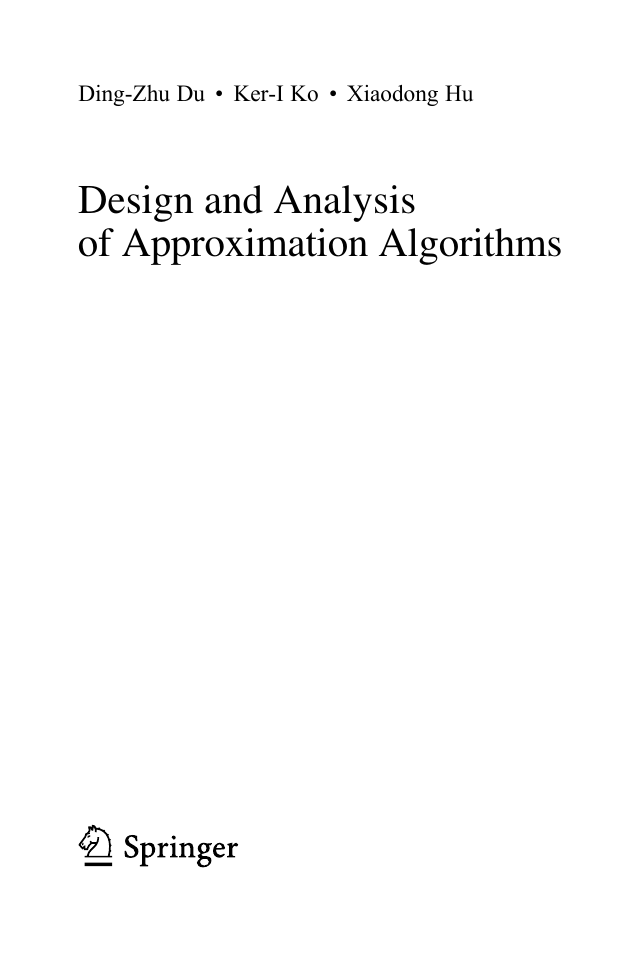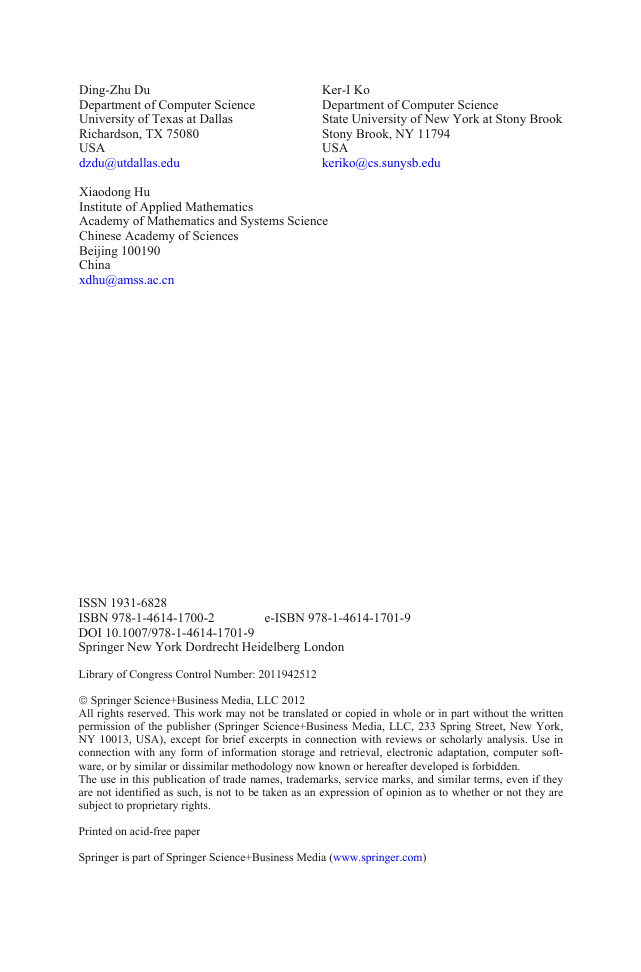�
Springer Optimization and Its Applications
VOLUME 62
Managing Editor
Panos M. Pardalos (University of Florida)
Editor–Combinatorial Optimization
Ding-Zhu Du (University of Texas at Dallas)
Advisory Board
J. Birge (University of Chicago)
C.A. Floudas (Princeton University)
F. Giannessi (University of Pisa)
H.D. Sherali (Virginia Polytechnic and State University)
T. Terlaky (McMaster University)
Y. Ye (Stanford University)
Aims and Scope
Optimization has been expanding in all directions at an astonishing rate
during the last few decades. New algorithmic and theoretical techniques
have been developed, the diffusion into other disciplines has proceeded at
a rapid pace, and our knowledge of all aspects of the field has grown even
more profound. At the same time, one of the most striking trends in opti-
mization is the constantly increasing emphasis on the interdisciplinary na-
ture of the field. Optimization has been a basic tool in all areas of applied
mathematics, engineering, medicine, economics, and other sciences.
The series Springer Optimization and Its Applications publishes under-
graduate and graduate textbooks, monographs and state-of-the-art exposi-
tory work that focus on algorithms for solving optimization problems and
also study applications involving such problems. Some of the topics covered
include nonlinear optimization (convex and nonconvex), network flow prob-
lems, stochastic optimization, optimal control, discrete optimization, multi-
objective programming, description of software packages, approximation
techniques and heuristic approaches.
For further volumes:
http://www.springer.com/series/7393
�
Ding-Zhu Du •Ker-I KoDesign and Analysisof Approximation AlgorithmsXiaodong Hu•�
Ding-Zhu Du Ker-I Ko Department of Computer Science Department of Computer Science University of Texas at Dallas State University of New York at Stony Brook Richardson, TX 75080 Stony Brook, NY 11794 USA USA dzdu@utdallas.edu keriko@cs.sunysb.edu Xiaodong Hu Institute of Applied Mathematics Academy of Mathematics and Systems Science Chinese Academy of Sciences Beijing 100190 China xdhu@amss.ac.cn ISSN 1931-6828 ISBN 978-1-4614-1700-2 e-ISBN 978-1-4614-1701-9 DOI 10.1007/978-1-4614-1701-9 Springer New York Dordrecht Heidelberg London Library of Congress Control Number: Springer Science+Business Media, LLC 2012 All rights reserved. This work may not be translated or copied in whole or in part without the written permission of the publisher (Springer Science+Business Media, LLC, 233 Spring Street, New York, NY 10013, USA), except for brief excerpts in connection with reviews or scholarly analysis. Use in connection with any form of information storage and retrieval, electronic adaptation, computer soft-ware, or by similar or dissimilar methodology now known or hereafter developed is forbidden. The use in this publication of trade names, trademarks, service marks, and similar terms, even if they are not identified as such, is not to be taken as an expression of opinion as to whether or not they are subject to proprietary rights. Printed on acid-free paper Springer is part of Springer Science+Business Media (www.springer.com) 2011942512�
PrefaceAnapproximationalgorithmisanefficientalgorithmthatproducessolutionstoanoptimizationproblemthatareguaranteedtobewithinafixedratiooftheoptimalsolution.Insteadofspendinganexponentialamountoftimefindingtheoptimalsolution,anapproximationalgorithmsettlesfornear-optimalsolutionswithinpoly-nomialtimeintheinputsize.Approximationalgorithmshavebeenstudiedsincethemid-1960s.Theirimportancewas,however,notfullyunderstooduntilthediscov-eryoftheNP-completenesstheory.Manywell-knownoptimizationproblemshavebeenproved,underreasonableassumptionsinthistheory,tobeintractable,inthesensethatoptimalsolutionstotheseproblemsarenotcomputablewithinpolyno-mialtime.Asaconsequence,near-optimalapproximationalgorithmsarethebestonecanexpectwhentryingtosolvetheseproblems.Inthepastdecade,theareaofapproximationalgorithmshasexperiencedanex-plosiverateofgrowth.Thisgrowthrateispartlyduetothedevelopmentofrelatedresearchareas,suchasdatamining,communicationnetworks,bioinformatics,andcomputationalgametheory.Thesenewlyestablishedresearchareasgeneratealargenumberofnew,intractableoptimizationproblems,mostofwhichhavedirectappli-cationstoreal-worldproblems,andsoefficientapproximatesolutionstothemareactivelysoughtafter.Inadditiontotheexternal,practicalneedforefficientapproximationalgorithms,thereisalsoanintrinsic,theoreticalmotivebehindtheresearchofapproximationalgorithms.Inthedesignofanexact-solutionalgorithm,themain,andoftenonly,measureofthealgorithm’sperformanceisitsrunningtime.Thisfixedmeasureof-tenlimitsourchoiceoftechniquesinthealgorithm’sdesign.Foranapproximationalgorithm,however,thereisanequallyimportantsecondmeasure,thatis,theper-formanceratioofthealgorithm,whichmeasureshowclosetheapproximational-v�
viPrefacegorithm’soutputistotheoptimalsolution.Thismeasureaddsanewdimensiontothedesignandanalysisofapproximationalgorithms.Namely,wecannowstudythetradeoffbetweentherunningtimeandtheperformanceratioofapproximationalgo-rithms,andapplydifferentdesigntechniquestoachievedifferenttradeoffsbetweenthesetwomeasures.Inaddition,newtheoreticalissuesabouttheapproximationtoanoptimizationproblemneedtobeaddressed:Whatistheperformanceratioofanapproximationalgorithmforthisproblembasedoncertaintypesofdesignstrategy?Whatisthebestperformanceratioofanypolynomial-timeapproximationalgorithmforthisproblem?Doestheproblemhaveapolynomial-timeapproximationschemeorafullypolynomial-timeapproximationscheme?Thesequestionsarenotonlyofsignificanceinpracticeforthedesignofapproximationalgorithms;theyarealsoofgreattheoreticalinterest,withintriguingconnectionstotheNP-completenessthe-ory.Motivatedbythesetheoreticalquestionsandthegreatnumberofnewlydiscov-eredoptimizationproblems,peoplehavedevelopedmanynewdesigntechniquesforapproximationalgorithms,includingthegreedystrategy,therestrictionmethod,therelaxationmethod,partition,localsearch,powergraphs,andlinearandsemidef-initeprogramming.Acomprehensivesurveyofallthesemethodsandresultsinasinglebookisnotpossible.Weinsteadprovideinthisbookanintensivestudyofthemainmethods,withabundantapplicationsfollowingourdiscussionofeachmethod.Indeed,thisbookisorganizedaccordingtodesignmethodsinsteadofapplicationproblems.Thus,onecanstudyapproximationalgorithmsofthesamenatureto-gether,andlearnaboutthedesigntechniquesinamoreunifiedway.Tothisend,thebookisarrangedinthefollowingway:First,inChapter1,wegiveabriefintroduc-tiontotheconceptofNP-completenessandapproximationalgorithms.InChapter2,wegiveanin-depthanalysisofthegreedystrategy,includinggreedyalgorithmswithsubmodularpotentialfunctionsandthosewithnonsubmodularpotentialfunc-tions.InChapters3,4,and5,wecovervariousrestrictionmethods,includingpar-titionandGuillotinecutmethods,withapplicationstomanygeometricproblems.Inthenextfourchapters,westudytherelaxationmethods.InadditiontoageneraldiscussionoftherelaxationmethodinChapter6,wedevotethreechapterstoap-proximationalgorithmsbasedonlinearandsemidefiniteprogramming,includingtheprimal-dualschemaanditsequivalencewiththelocalratiomethod.Finally,inChapter10,wepresentvariousinapproximabilityresultsbasedonrecentworkintheNP-completenesstheory.Anumberofexamplesandexercisesareprovidedforeachdesigntechnique.Theyaredrawnfromdiverseareasofresearch,includingcommunicationnetworkdesign,opticalnetworks,wirelessadhocnetworks,sensornetworks,bioinformatics,socialnetworks,industrialengineering,andinformationmanagementsystems.ThisbookhasgrownoutoflecturenotesusedbytheauthorsattheUniversityofMinnesota,UniversityofTexasatDallas,TsinghuaUniversity,GraduateSchoolofChineseAcademyofSciences,Xi’anJiaotongUniversity,ZhejiangUniversity,EastChinaNormalUniversity,DalianUniversityofTechnology,XinjiangUniver-sity,NankaiUniversity,LanzhouJiaotongUniversity,XidianUniversity,andHarbinInstituteofTechnology.Inatypicalone-semesterclassforfirst-yeargraduatestu-�
Prefaceviidents,onemaycoverthefirsttwochapters,oneortwochaptersontherestrictionmethod,twoorthreechaptersontherelaxationmethod,andChapter10.Withmoreadvancedstudents,onemayalsoteachaseminarcoursefocusingononeofthegreedy,restriction,orrelaxationmethods,basedonthecorrespondingchaptersofthisbookandsupplementarymaterialfromrecentresearchpapers.Forinstance,aseminaroncombinatorialoptimizationemphasizingapproximationsbasedonlinearandsemidefiniteprogrammingcanbeorganizedusingChapters7,8,and9.Thisbookhasbenefitedmuchfromthehelpofourfriends,colleagues,andstu-dents.WeareindebtedtoPeng-JunWan,WeiliWu,XiuzhenCheng,JieWang,Yin-fengXu,ZhaoZhang,DeyingLi,HejiaoHuang,HongZhu,GuochuanZhang,WeiWang,ShugangGao,XiaofengGao,FengZou,LingDing,XianyueLi,MyT.Thai,DonghyunKim,J.K.Willson,andRoozbehEbrahimiSoorchaei,whomademuch-valuedsuggestionsandcorrectionstotheearlierdraftsofthebook.WearealsogratefultoProfessorsFrancesYao,RichardKarp,RonaldGraham,andFanChungfortheirencouragement.SpecialthanksareduetoProfessorAndrewYaoandtheInstituteforTheoreticalComputerScience,TsinghuaUniversity,forthegeneroussupportandstimulatingenvironmenttheyprovidedforthefirsttwoauthorsduringtheirnumerousvisitstoTsinghuaUniversity.Dallas,TexasDing-ZhuDuStonyBrook,NewYorkKer-IKoBeijing,ChinaXiaodongHuAugust2011�
















 2023年江西萍乡中考道德与法治真题及答案.doc
2023年江西萍乡中考道德与法治真题及答案.doc 2012年重庆南川中考生物真题及答案.doc
2012年重庆南川中考生物真题及答案.doc 2013年江西师范大学地理学综合及文艺理论基础考研真题.doc
2013年江西师范大学地理学综合及文艺理论基础考研真题.doc 2020年四川甘孜小升初语文真题及答案I卷.doc
2020年四川甘孜小升初语文真题及答案I卷.doc 2020年注册岩土工程师专业基础考试真题及答案.doc
2020年注册岩土工程师专业基础考试真题及答案.doc 2023-2024学年福建省厦门市九年级上学期数学月考试题及答案.doc
2023-2024学年福建省厦门市九年级上学期数学月考试题及答案.doc 2021-2022学年辽宁省沈阳市大东区九年级上学期语文期末试题及答案.doc
2021-2022学年辽宁省沈阳市大东区九年级上学期语文期末试题及答案.doc 2022-2023学年北京东城区初三第一学期物理期末试卷及答案.doc
2022-2023学年北京东城区初三第一学期物理期末试卷及答案.doc 2018上半年江西教师资格初中地理学科知识与教学能力真题及答案.doc
2018上半年江西教师资格初中地理学科知识与教学能力真题及答案.doc 2012年河北国家公务员申论考试真题及答案-省级.doc
2012年河北国家公务员申论考试真题及答案-省级.doc 2020-2021学年江苏省扬州市江都区邵樊片九年级上学期数学第一次质量检测试题及答案.doc
2020-2021学年江苏省扬州市江都区邵樊片九年级上学期数学第一次质量检测试题及答案.doc 2022下半年黑龙江教师资格证中学综合素质真题及答案.doc
2022下半年黑龙江教师资格证中学综合素质真题及答案.doc